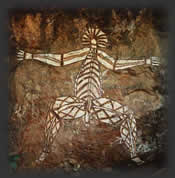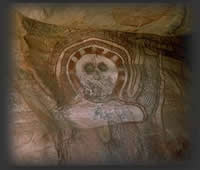“But,
after all, who knows, and who can say whence it all came, and how creation
happened?”
Rig Veda* X, 129.
Each and every one of us is born into a tradition; even when our parents do not profess a belief, we still have access to a variety of histories—familial, local and national—that help to define us. What makes one history more ‘sacred’ than another is perhaps the measure to which it gives our life meaning. For some, meaning comes readily from inherited tradition; for others, it is much harder to acquire.
*Veda, literally ‘knowledge’. The Rig Veda is the earliest of the Hindu scriptures, written in Sanskrit and dating anywhere from 4000-1500 BCE.

Rock
painting, c. 6000 BCE**, Australia

Churinga

Cave painting of a Wandjina spirit,
Western Austalia
For the Aboriginal people of Australia, the coming into being of the earth and all its creatures occurred in the alcheringa or Dreamtime. Each tribe has its myths of the wanderings of the primordial beings that shaped the landscape and populated it with plants, animals and humans. Upon finishing their work and before returning to the spirit realm, these beings performed a series of ritual acts which—when scrupulously re-enacted—are capable of conjuring this mythic past and reinvigorating the world. Thus, for the Aborigines, the events that constitute their sacred history occurred at the dawn of creation, yet are also still happening in the present.
It is said of the Wandjina spirits of Western Australia (see above right) that they impressed their images in the caves before returning to the spirit realm. Every such image ‘belongs’ to one of the clans, and the stories, songs, rights and responsibilities associated with that image—such as ensuring its renewal through regular repainting—are handed down through the generations. This periodic renovation is a spiritual exercise, necessary for the maintenance of creation; should the ceremonies be neglected, it is believed, the world would regress to chaos.
Another imprint of Aboriginal sacred history can be found on the ritual implements known as churingas (above centre), sacred artefacts imaging both journey and story. When correctly interpreted, these symbolic maps guide initiates through the song cycles. The chanting of the tradition encoded on a churinga is important in that it conjures the Dreamtime; only when the connection to alcheringa is established can the present world be renewed.
In the Aboriginal worldview, every meaningful activity, event, or life process leaves behind a vibrational residue, a ‘seed power’ (jiva or guruwari) drawn from sources originally deposited in the earth by the alcheringa beings; thus, everything in the natural world is a mirror of the Dreamtime, the very surroundings vibrating with the echo of the original creative acts.
The disclosure of Aboriginal sacred history often takes several years, the individual becoming more aware of the import of the past with each progressive stage. They are initiated into the process of reliving the alcheringa, and as the revelation conserved in the myths becomes assimilated, present life becomes meaningful and sacred.
**BCE, ‘before the common era’. Used in place of BC, ‘before Christ’.